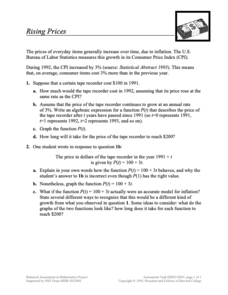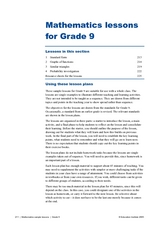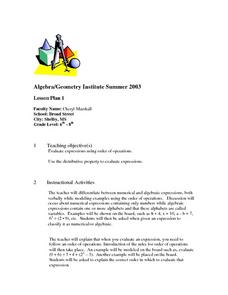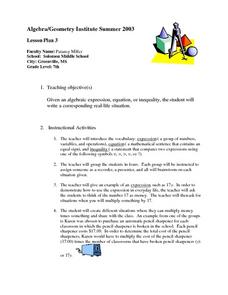Illustrative Mathematics
Gotham City Taxis
Taxi! Have your travelers figure out how far they can go in a taxi for $10.00. They must account for the mileage rate and tip in their calculation. They can set up a table or make an equation to solve for the exact mileage they can...
EngageNY
What Is a Trigonometric Identity?
Protect yourself from identity theft! Establishing a strong understanding of the Pythagorean identity allows learners to prove that sine^2x + cos^2x = 1. They then use the identity to find sine or cosine ratios given the other.
Noyce Foundation
Truffles
Knowing how to scale a recipe is an important skill. Young mathematicians determine the amount of ingredients they need to make a certain number of truffles when given a recipe. They determine a relationship between ingredients given a...
Noyce Foundation
Gym
Give the class a mental work out with an assessment task in which young mathematicians compare several gym membership options. They use substitution to calculate the cost for given numbers of months.
Concord Consortium
Rising Prices
What will that cost in the future? The scenario provides pupils with a growth as a Consumer Price Index. Learners create functions for a given item to determine future prices and graph them. Class members then compare their functions to...
Curated OER
Applications Using Rational Equations
Algebra learners explore the concept of writing equations using rational expressions. This work sheet contains a number of word problems including reciprocal number problems, work problems, and problems can that be solved using...
Education Institute
Four Mathematics Lessons for Grade 9
These four lesson plans build algebra skills for working with numbers in exponential form and for examining triangles. Be aware that in the text, scientific notation is referred to as index notation and the laws of exponents as the laws...
Curated OER
Logistic Growth Model, Explicit Version
Via the concrete setting of estimating the population of the US, your algebra learners are introduced to a logistic growth model. Comparing and contrasting logistic, exponential, linear and quadratic models, to see which fits the data...
Curated OER
Solving Factorable Quadratic Equations
In this quadratic equations worksheet, 9th graders solve 10 different problems that include factorable quadratic equations. First, they move all the terms to the same side and set the equation to 0. Then, students factor the algebraic...
Curated OER
Function Tables
In this function tables worksheet, 11th graders solve 10 different problems that include completing various function tables. First, they read and identify each rule given for the tables. Then, students use the rule to determine the input...
Curated OER
Integers
In this algebra worksheet, students solve problems through addition, subtraction, multiplication and division, by following the order of operation. There are 10 problems with ananswer key.
Curated OER
Combining Like Terms
Students define terminology used in simplifying equations. In this algebra lesson, students combine like terms to solve an equation. They use substitution, division, addition and subtractions to help simplify the equation. They multiply...
Curated OER
Evaluating Using The Order of Operations
Scholars are introduced to the usage of the Order of Operations. They explore the use of variables and how they are represented by any letter of the alphabet. They then engage in discussion for verbal assessment.
Curated OER
Understanding Variables
Students solve linear equations and identify the unknown. In this algebra lesson, students define a variable and use addition, subtraction, multiplication and division to solve. They change the equation depending on the value of the...
Illustrative Mathematics
Slopes and Circles
An upper-level treatment of what is often presented as a basic concept (the right angle of an inscribed circle on the diameter), this activity really elevates the mathematical thought of the learner! Expected to develop formulas...
Illustrative Mathematics
Watch Out for Parentheses 1
Parentheses are an important tool in the algebraic toolbox in regard to the structure of the algebraic equation. They are the beginning of the standard order of operations rule, the P in PEMDAS. The central question...
Curated OER
Real Life Situations
Pupils investigate different equations and think critically how they could represent a real-life situation. They should write a word problem to coincide with the given equations. The instructional activity requires students to use...
Curated OER
Working With Equations
Young scholars create a mathematical formula to help plan ration supplies for a polar expedition. Using basic algebra skills, students identify the variables in planning for rations. They create an equation to help plan the expedition....
Curated OER
Factoring: All Types
In this factor worksheet, algebra learners factor expressions containing two to four terms. This one-page worksheet contains 15 problems, with answers.
Curated OER
A Beginning Look at Basic Algebra-Lesson 1-12
In this Algebra I worksheet, 9th graders explore the basic of beginning algebra: the order of operations, integer operations, translating phrases and sentences, and solving basic one-step equations. The six page worksheet...
Curated OER
Operation Sense
Pupils investigate the order of operation in algebraic equations. In this order of operations instructional activity, students discover the proper order for solving single variable equations.
Curated OER
Order of Operation
Students solve problems using the order of operation. For this algebra lesson, students factor, subtract, add and divide using the correct order to remove parentheses. They simplify expressions by combining like terms.
Curated OER
Order of Operations: Pages 19-24
In this math worksheet, students evaluate 15 expressions using the order of operations. Students then evaluate 4 more expressions with given numerical values for variables.
Curated OER
"Bats on Parade" by Kathy Appelt
Students examine numbers and try to find a pattern in their relationship. They write an algebraic expression for the nth term.

























